一.原理介绍
这一节将树模型的预测与概率分布相结合,我们假设树模型的输出服从某一分布,而我们的目标是使得该输出的概率尽可能的高,如下图所示
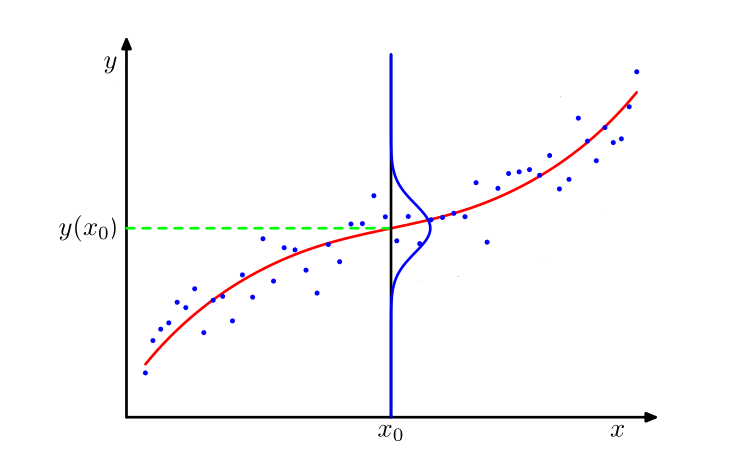
而概率值最高的点通常由分布中的某一个参数(通常是均值)反映,所以我们将树模型的输出打造为分布中的该参数项,然后让树模型的输出去逼近极大似然估计的结果即可,即:
下面分别介绍possion回归,gamma回归,tweedie回归,负二项回归的具体求解
二.泊松回归
泊松分布的表达式如下:
其中,(y)是我们的目标输出,(lambda)为模型参数,且(lambda)恰为该分布的均值,由于泊松分布要求(y>0),所以我们对(hat{y})取指数去拟合(lambda),即令:
对于(N)个样本,其似然函数可以表示如下:
由于(y_i!)是常数,可以去掉,并对上式取负对数,转换为求极小值的问题:
所以,一阶导和二阶导分别为:
三.gamma回归
gamma分布如下:
其中,(y>0)为我们的目标输出,(alpha)为形状参数,(lambda)为尺度参数,(Gamma(cdot))为Gamma函数(后续推导这里会被省略,所以就不列出来了),而Gamma分布的均值为(alphalambda),这里不好直接变换,我们令(alpha=1/phi,lambda=phimu),所以现在Gamma分布的均值可以表示为(mu),此时的Gamma分布为:
此时,(mu)看做Gamma分布的均值参数,而(phi)为它的离散参数,在均值给定的情况下,若离散参数越大,Gamma分布的离散程度越大,接下来对上面的表达式进一步变换:
同泊松分布一样,我们可以令:
又由于(mu)与(phi)无关,所以做极大似然估计时可以将(phi)看做常数,我们将对数似然函数的负数看做损失函数,可以写作如下:
所以,一阶导和二阶导就可以写出来啦:
注意:上面的两个向量是按元素相乘
四.tweedie回归
tweedie回归是多个分布的组合体,包括gamma分布,泊松分布,高斯分布等,tweedie回归由一个超参数(p)控制,(p)不同,则其对应的对数似然函数也不同:
同样的,我们可以令:
由于除开(mu)以外的都可以视作常数项,所以损失函数可以简化为:
所以,一阶导:
二阶导:
五.代码实现
基于上一节的计算框架,略作调整即可实现....
import os
os.chdir('../')
import matplotlib.pyplot as plt
%matplotlib inline
from ml_models.ensemble import XGBoostBaseTree
from ml_models import utils
import copy
import numpy as np
"""
xgboost回归树的实现,封装到ml_models.ensemble
"""
class XGBoostRegressor(object):
def __init__(self, base_estimator=None, n_estimators=10, learning_rate=1.0, loss='squarederror', p=2.5):
"""
:param base_estimator: 基学习器
:param n_estimators: 基学习器迭代数量
:param learning_rate: 学习率,降低后续基学习器的权重,避免过拟合
:param loss:损失函数,支持squarederror、logistic、poisson,gamma,tweedie
:param p:对tweedie回归生效
"""
self.base_estimator = base_estimator
self.n_estimators = n_estimators
self.learning_rate = learning_rate
if self.base_estimator is None:
# 默认使用决策树桩
self.base_estimator = XGBoostBaseTree()
# 同质分类器
if type(base_estimator) != list:
estimator = self.base_estimator
self.base_estimator = [copy.deepcopy(estimator) for _ in range(0, self.n_estimators)]
# 异质分类器
else:
self.n_estimators = len(self.base_estimator)
self.loss = loss
self.p = p
def _get_gradient_hess(self, y, y_pred):
"""
获取一阶、二阶导数信息
:param y:真实值
:param y_pred:预测值
:return:
"""
if self.loss == 'squarederror':
return y_pred - y, np.ones_like(y)
elif self.loss == 'logistic':
return utils.sigmoid(y_pred) - utils.sigmoid(y), utils.sigmoid(y_pred) * (1 - utils.sigmoid(y_pred))
elif self.loss == 'poisson':
return np.exp(y_pred) - y, np.exp(y_pred)
elif self.loss == 'gamma':
return 1.0 - y * np.exp(-1.0 * y_pred), y * np.exp(-1.0 * y_pred)
elif self.loss == 'tweedie':
if self.p == 1:
return np.exp(y_pred) - y, np.exp(y_pred)
elif self.p == 2:
return 1.0 - y * np.exp(-1.0 * y_pred), y * np.exp(-1.0 * y_pred)
else:
return np.exp(y_pred * (2.0 - self.p)) - y * np.exp(y_pred * (1.0 - self.p)), (2.0 - self.p) * np.exp(
y_pred * (2.0 - self.p)) - (1.0 - self.p) * y * np.exp(y_pred * (1.0 - self.p))
def fit(self, x, y):
y_pred = np.zeros_like(y)
g, h = self._get_gradient_hess(y, y_pred)
for index in range(0, self.n_estimators):
self.base_estimator[index].fit(x, g, h)
y_pred += self.base_estimator[index].predict(x) * self.learning_rate
g, h = self._get_gradient_hess(y, y_pred)
def predict(self, x):
rst_np = np.sum(
[self.base_estimator[0].predict(x)] +
[self.learning_rate * self.base_estimator[i].predict(x) for i in
range(1, self.n_estimators - 1)] +
[self.base_estimator[self.n_estimators - 1].predict(x)]
, axis=0)
if self.loss in ["poisson", "gamma", "tweedie"]:
return np.exp(rst_np)
else:
return rst_np
对泊松、gamma、tweedie回归做测试
data = np.linspace(1, 10, num=100)
target = np.sin(data) + np.random.random(size=100) + 1 # 添加噪声
data = data.reshape((-1, 1))
model = XGBoostRegressor(loss='poisson')
model.fit(data, target)
plt.scatter(data, target)
plt.plot(data, model.predict(data), color='r')
[<matplotlib.lines.Line2D at 0x29c33c1a9b0>]
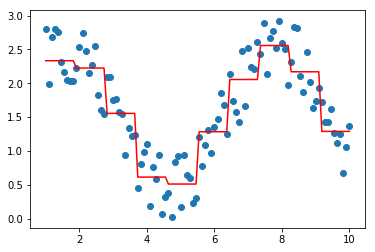
model = XGBoostRegressor(loss='gamma')
model.fit(data, target)
plt.scatter(data, target)
plt.plot(data, model.predict(data), color='r')
[<matplotlib.lines.Line2D at 0x29c33c1a400>]
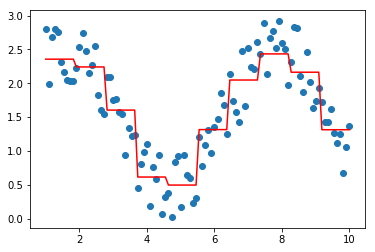
model = XGBoostRegressor(loss='tweedie',p=2.5)
model.fit(data, target)
plt.scatter(data, target)
plt.plot(data, model.predict(data), color='r')
[<matplotlib.lines.Line2D at 0x29c33c1aba8>]
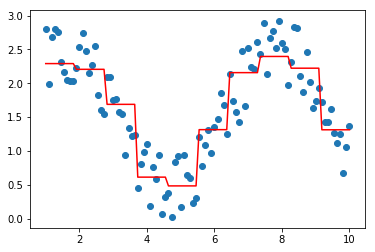
model = XGBoostRegressor(loss='tweedie',p=1.5)
model.fit(data, target)
plt.scatter(data, target)
plt.plot(data, model.predict(data), color='r')
[<matplotlib.lines.Line2D at 0x29c33c43d68>]
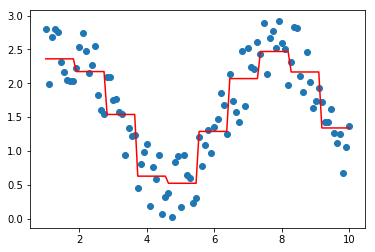
上面的拟合结果,看不出明显区别....,接下来对tweedie分布中p取极端值做一个简单探索...,可以发现取值过大或者过小都有可能陷入欠拟合
model = XGBoostRegressor(loss='tweedie',p=0.1)
model.fit(data, target)
plt.scatter(data, target)
plt.plot(data, model.predict(data), color='r')
[<matplotlib.lines.Line2D at 0x29c44ed2cc0>]
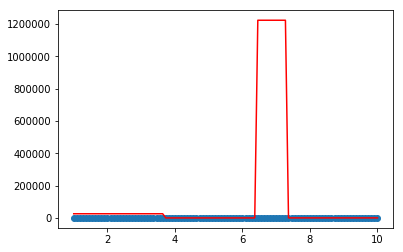
model = XGBoostRegressor(loss='tweedie',p=20)
model.fit(data, target)
plt.scatter(data, target)
plt.plot(data, model.predict(data), color='r')
[<matplotlib.lines.Line2D at 0x29c44e94f28>]

参考内容:
http://www.doc88.com/p-9029670237688.html
http://docs.h2o.ai/h2o/latest-stable/h2o-docs/data-science/glm.html#families